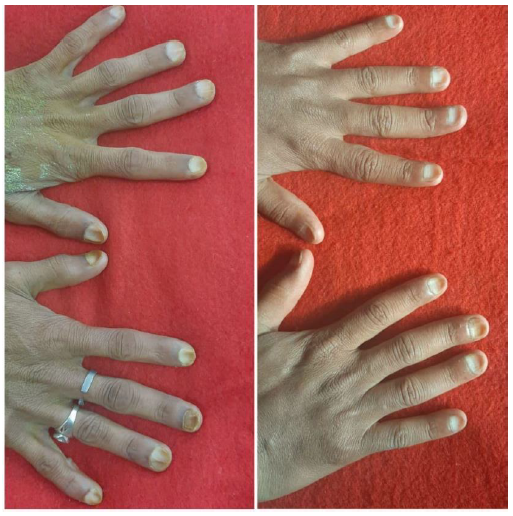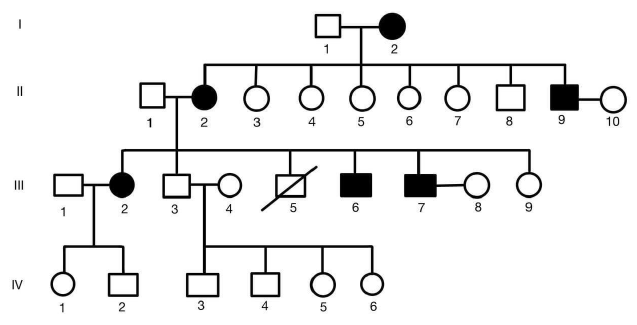Familial Koilonychia Associated with Male Infertility
Article Information
Simrat Kaur Batth1*, Ishani Thukral2, Ajay Chhabra2
1Punjab Institute of Medical Sciences, Jalandhar, India
2Government Medical College, Amritsar, India
*Corresponding author: Simrat Kaur Batth, Punjab Institute of Medical Sciences, Jalandhar, India
Received: 21 July 2021; Accepted: 28 July 2021; Published: 05 August 2021
Citation:
Simrat Kaur Batth, Ishani Thukral, Ajay Chhabra. Familial Koilonychia Associated with Male Infertility. Archives of Internal Medicine Research 4 (2021): 196-199.
Share at FacebookAbstract
Koilonychia has a myriad of associations with dermatologic and systemic disorders. Iron deficiency isone of the most common causes worldwide. Familia koilonychia is one of the hereditary causes of koilonychia.The genetic mutations causing it is not entirely known. Familial koilonychia is a rare condition and mostly an isolated finding. Its association with male infertility points towards the possibility of it being one of the phenotypes of a systemic disorder that is yet to be known. Male infertility workup should always be started with a semen analysis. A proper history taking and a thorough physical examination in a patient can help reveal many of the underlying conditions unrelated to the cause of presentation in the hospital.
Keywords
Familial Koilonychia, Male Infertility
Familial Koilonychia articles; Male Infertility articles
Article Details
1. Introduction
Koilonychia is also called spoon-shaped (concave) nails. The nail abnormality is characterized by thin, brittle, concave nail dystrophy either placed horizontally or vertically, where the finger or toenail plate seems to be centrally depressed and everted laterally [1]. An appropriate workup is important to exclude an underlying cutaneous or systemic disorder, and the workup should be based on patient profile, clinical history, and physical examination for a better understanding of the underlying condition.
2. Case Presentation
A 38-year-old patient presented to the emergency department with hepatic encephalopathy due to alcoholic liver cirrhosis. He was stabilized and started on appropriate medications. On general physical examination, koilonychia was noted on his hands and feet. The patient’s hemoglobin was 13 gm/dl with a high ferritin level of 812 ng/ml, likely due to chronic liver disease. Similar nail findings were also reported in his brother, who accompanied him, with normal ferritin levels (Figure 1). Nail specimens were obtained for KOH smear and fungal culture from both, which came out to be negative. This ruled out iron deficiency and onychomycosis as the cause of koilonychia. Detailed family history revealed familial occurrence of abnormal nails since childhood. In addition, the patient’s brother has had an infertility workup and reported that all the affected male members of the family do not have a child. We conducted a complete pedigree analysis (Figure 2). Hormonal evaluation of the patient and his brother revealed normal testosterone, prolactin, LH, and FSH levels. The patient refused to undergo further investigation while his brother gave the consent. Semen analysis, conducted twice two weeks apart, revealed no sperms in the semen. Hormonal and semen analysis pointed towards an obstructive cause of azoospermia. The color-doppler ultrasonography (USG) scrotum detected no abnormality. A testicular biopsy could not be performed.
3. Discussion
Koilonychia may be due to hereditary or congenital, acquired, and idiopathic causes. It is primarily considered to be a manifestation of chronic iron deficiency anemia. The pathophysiology of koilonychia is poorly understood. Familial koilonychia is a rare condition, usually transmitted through autosomal dominant inheritance [2]. It usually presents at birth or within the initial few years of life [3]. The nails in these patients are typically thin and flat and develop various degrees of concavity over time. However, within the same family members, the variable expression may be noticed with only affection of fingernails or selected fingers or toes only or fingernails on one hand or with accentuation of the great toe and/ or thumb [3], Although there have been case reports on familial koilonychia [2], only one case till date has been reported on the association between familial koilonychia and azoospermia [4]. Even though we could not investigate further but all the lab and imaging results pointed towards an obstructive cause of azoospermia. Transscrotal USG is not sensitive enough to detect all the obstructive abnormalities, so other imaging modalities like transrectal ultrasonography (TRUS), TRUS-guided seminal vesiculography, seminal tract washout, vasography, endorectal magnetic resonance imaging, abdominal USG and cranial imaging may be needed to evaluate males with azoospermia. In evaluating azoospermic males who have normal-sized testis and a normal hormone profile, a testicular biopsy is critical for establishing the diagnosis of obstructive azoospermia [5]. Patients with azoospermia should be referred to a urologist specialized in infertility for further evaluation and treatment [5].
4. Conclusion
To report a rare association of male infertility with familial koilonychia and demonstrate the importance of a carefully taken history with an emphasis on family history along with physical examination while evaluating a case of koilonychia.
Declarations
Funding: not applicable
Conflicts of interests: there are no conflicts of interests among all authors
Ethics approval: not applicable
Consent to participate: consent for participate was obtained from all authors
Consent for publication: consent for publication was obtained from all authors
Availability of data and material: the data that supports the findings of this study is available from the
corresponding author on reasonable request
Code availability: not applicable
Author’s contributions: S.K.B. and I.T. contributed equally. S.K.B and I.T. collected the data, evaluated the patient
and wrote the manuscript. A.C. managed the patient clinically.
References
- Rathod DG, Sonthalia S. Spoon Nails. In: StatPearls (2021).
- Prathap P, Asokan N. Familial Koilonychia. Indian J Dermatol 55 (2010): 406-407.
- Walker J, Baran R, Vélez N, et al. Koilonychia: an update on pathophysiology, differential diagnosis and clinical relevance. J Eur Acad Dermatol Venereol JEADV 30 (2016): 1985-1991.
- Agarwal P, Pursnani N, Singh B, et al. A rare case report of familial koilonychia with azoospermia. J Dr NTR Univ Health Sci 8 (2019): 229.
- Gudeloglu A, Parekattil SJ. Update in the evaluation of the azoospermic male. Clinics 68 (2013): 27-34.


